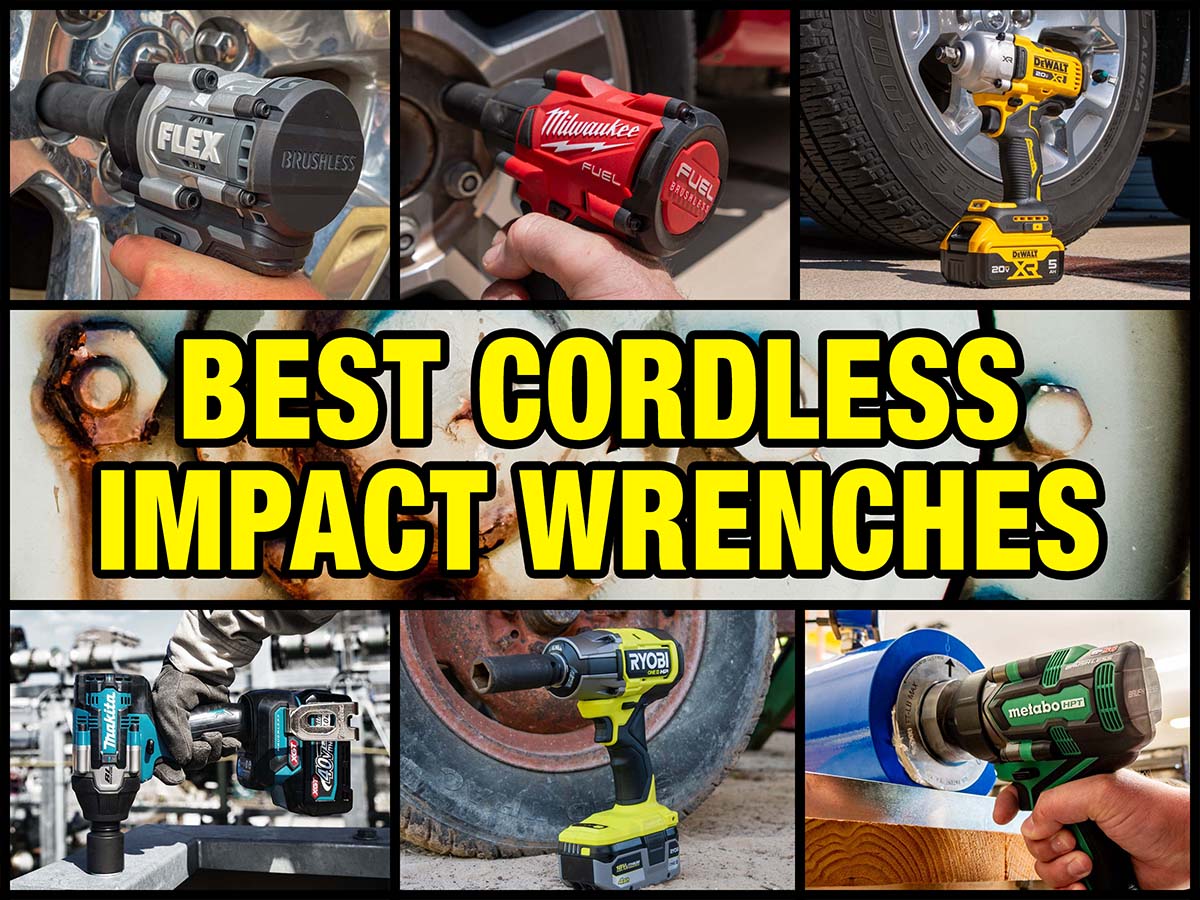Our 2025 search for the best cordless impact wrench featured ten mid-torque models that reached our head-to-head testing stage. Paired with the latest in battery technology, we pushed them to their limits to see who would emerge at the top. In the end, some of the most familiar names proved why they’re so popular among professional tradesmen.
Check out our article on the differences between impact drivers and impact wrenches!
The Best Cordless Impact Wrenches
- Best Overall: DeWalt 20V XR DCF891
↓ Jump to this Impact - Runner Up: Milwaukee M18 Fuel 2962
↓ Jump to this Impact - Third Place: Makita 40V XGT GWT07
↓ Jump to this Impact - Best for the Money: Ryobi 18V One+ HP Brushless P262
↓ Jump to this Impact
Scoring
Note that the scoring is different from our normal rating system. The scores are based on how each impact wrench performed and compared in this specific group and this set of tests only. Our typical rating system offers a comparison of the tool to the entire range of what is available. Here’s how to interpret the scores from this test:
- 90 – 100: Outstanding. You’ll love using this impact wrench.
- 80 – 89: Excellent. There may be minor tradeoffs.
- 70 – 79: Very good. There are more significant tradeoffs.
- 60 – 69: Good. Notable tradeoffs, but still earns our recommendation.
- < 60: Not recommended in the Pro mid-torque impact wrench class.
Jump to These Sections for More Information
- Other Models We Tested
- More Cordless Impact Wrench Reviews
- Test Group Comparison
- How We Tested with Full Results
- What to Look for When Buying an Impact Wrench
- Why You Can Trust Pro Tool Reviews
Best Cordless Impact Wrench Overall
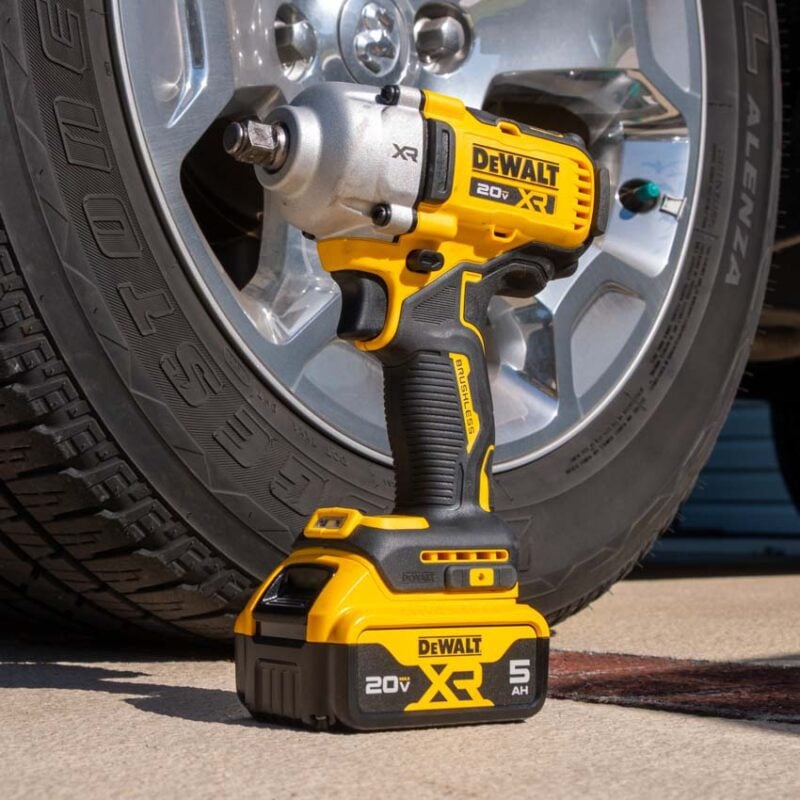
DeWalt 20V Max XR Impact Wrench DCF891
Score: 95 points
- Fastening Torque: 600 ft-bs
- Nut-Busting Torque: 800 ft-lbs
- Top Speeds: 600/1200/2000 RPM
- Max Impact Rate: 3250 IPM
- Bare Weight: 3.81 lbs
- Tested Weight: 5.95 lbs
- Length: 6.9 in
- Price: $279 bare, $469 kit
Pros
- Highest performance score
- Assist mode
- LED light controls
- Made in the USA w/ global materials
Cons
- No significant drawbacks
DeWalt’s DCF891 came away with the top honors in a close race. On paper, it was impressive, but we know real-world results make or break the final rankings.
Despite being tied for the highest fastening torque and owning the second-highest breakaway torque rating, it fell to mid-pack on our torque tester. However, in our application tests, DeWalt was dominant. It was the only model to average less than three seconds on our bolt-breaking rig and the only one to fully sink our lag screw.
The trade-offs are relatively minor in the grand scheme of things. It’s noticeably heavier than the lightest and longer than the most compact, but neither measurement strays into being a true negative.
From a feature perspective, it’s fairly basic, though the low/high/off LED light controls and the Precision Wrench control mode are useful upgrades. In the end, performance is our highest priority, and that’s what sets DeWalt ahead of the rest.
Head-to-Head Testing Results
| Test | w/ 8.0Ah PowerPack Battery |
|---|---|
| Breakaway | 2.97 sec (1st place) |
| Inertia Torque | 392.8 ft-lbs (5th place) |
| Lag Bolt Test | SUNK (1st tie) |
Best Cordless Impact Wrench Runner Up
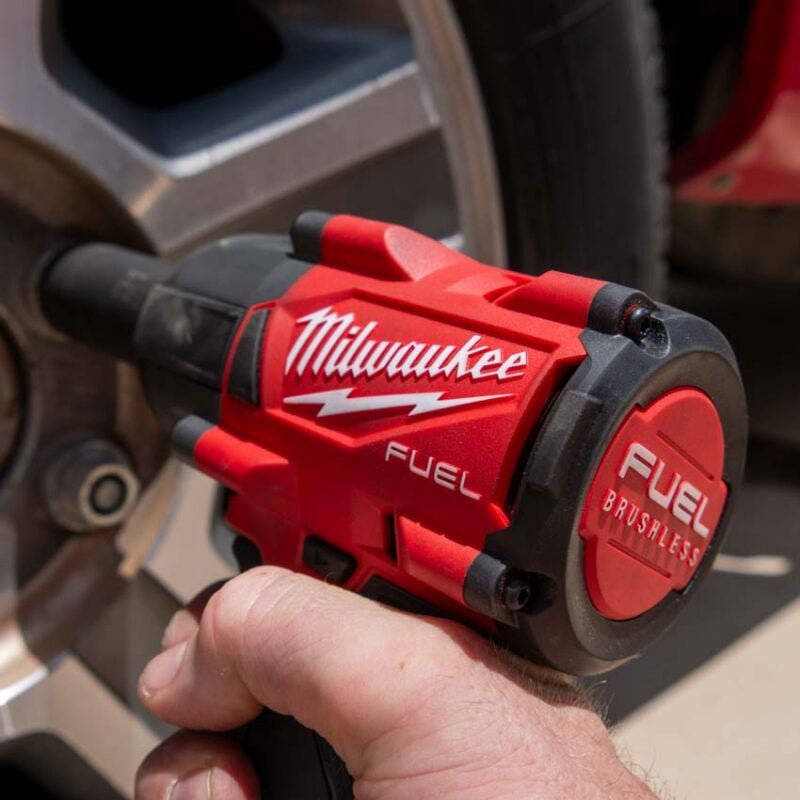
Milwaukee M18 Fuel Impact Wrench 2962
Score: 93 points
- Fastening Torque: 550 ft-bs
- Nut-Busting Torque: 650 ft-lbs
- Top Speeds: 1250/1950/2575 RPM
- Max Impact Rate: 3100 IPM
- Bare Weight: 3.56 lbs
- Tested Weight: 5.95 lbs
- Length: 5.9 in
- Price: $249 bare, $479 kit
Pros
- Most compact
- Excellent performance
- Assist mode
- Tri LED Ring
- 5-year warranty
Cons
- Friction ring fits tight on some sockets
Milwaukee announced their second-generation M18 Fuel mid-torque impact wrenches in the summer of 2020. Nearly five years later, it’s still fighting strong and earned a second place finish in our testing.
Its performance is solid, notching the second-fastest nut-busting speeds on our rig, along with competitive results on our torque tester and wood fastening test.
That high performance is packed into the most compact housing of the group, and that’s what makes this model so attractive. When you’re working around engine bays or equipment installed in tight areas, no other impact wrench in the mid-torque class has better access.
Similar to DeWalt, Milwaukee doesn’t go crazy with features. We love the Tri-LED light ring, though. It does a much better job of eliminating shadows around our work area than foot-mounted designs.
Head-to-Head Testing Results
| Test | w/ 6.0Ah Forge Battery |
|---|---|
| Breakaway | 3.26 sec (2nd place) |
| Inertia Torque | 412.8 ft-lbs (4th place) |
| Lag Bolt Test | 0.56 in (4th place) |
Third Place Cordless Impact Wrench
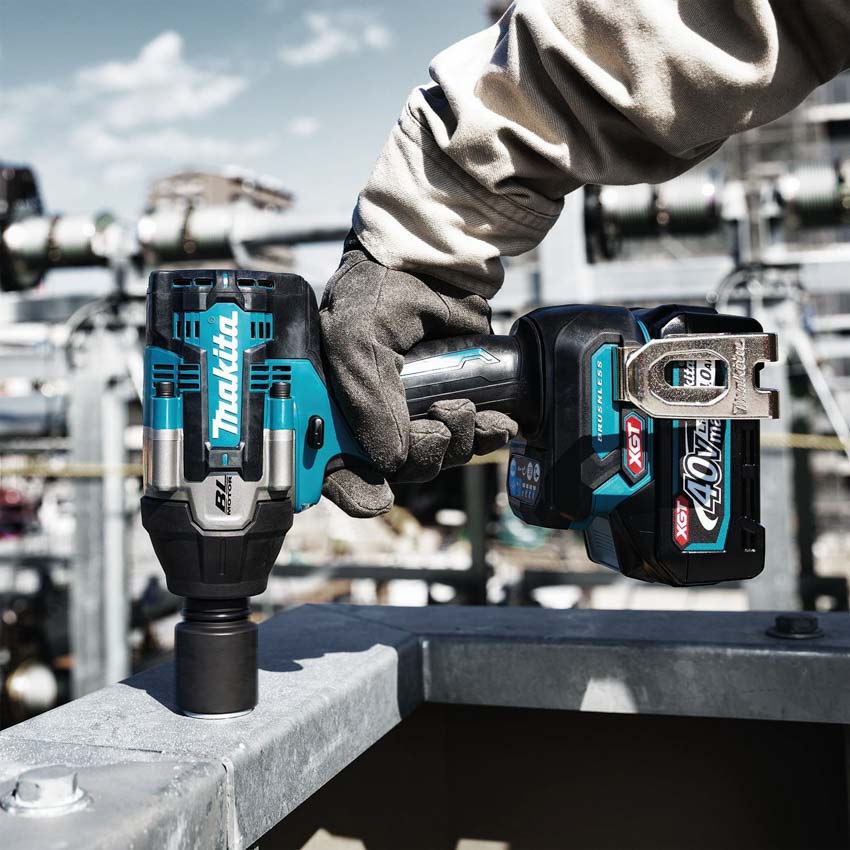
Makita 40V XGT Impact Wrench GWT07
Score: 91 points
- Fastening Torque: 560 ft-bs
- Nut-Busting Torque: 810 ft-lbs
- Top Speeds: 600/1200/1900/2300 RPM
- Max Impact Rate: 2900 IPM
- Bare Weight: 4.37 lbs
- Tested Weight: 6.45 lbs
- Length: 6.7 in
- Price: $394 bare, $609 kit
Pros
- Most powerful in terms of raw torque
- Four standard speeds
- Three assist modes
- Battery isolated from vibration
Cons
- Expensive
- Myriad of modes may confuse some users
- Lower impact rate
Makita’s GWT07 sets itself apart in several ways. On paper, it has the fourth highest fastening and the highest breakaway torque.
However, our inertia torque testing rig proved that this model is the strongest with respect to raw torque. In our application tests, it slid, though, notching just a 4th-place finish in our bolt break test and 7th on the lag screw. If it’s so strong, why wasn’t it closer to the top?
To answer that, we have to look at speed. Even though its top speed is 2300 RPM, its highest impact rate is 2900 IPM—the slowest of the group. So, it’s hitting harder than its competitors but not as frequently. It had no trouble breaking our bolts or moving the lag screw forward, it just needed some extra time to complete those tasks.
When it comes to control, Makita has very little competition. Four standard modes and three assist modes that work in both forward and reverse make this a go-to impact for automotive, concrete, utility, and any other application that requires precise control over fastening and loosening.
The advanced build and extra tech come at a cost, though, as this is one of the most expensive models we tested.
Head-to-Head Testing Results
| Test | w/4.0Ah High Power Battery |
|---|---|
| Breakaway | 4.08 sec (4th place) |
| Inertia Torque | 502.3 ft-lbs (1st place) |
| Lag Bolt Test | 2.00 in. (7th place) |
Best Cordless Impact Wrench for the Money

Ryobi 18V One+ HP Brushless Impact Wrench P262
Score: 86 points
- Fastening Torque: 450 ft-bs
- Nut-Busting Torque: 600 ft-lbs
- Top Speeds: 1200/2000/2800 RPM (2000 Auto)
- Max Impact Rate: 3200 IPM
- Bare Weight: 3.69 lbs
- Tested Weight: 5.19 lbs
- Length: 7.3 in
- Price: $179 bare, $238 kit
Pros
- Excellent value
- Outperformed several premium models
- Assist mode
- Low weight
- Tri LED light ring
Cons
- Longest head
Ryobi has a habit of blurring the line between DIY and Pro, and the P262 is no exception. Boasting competitive mid-torque specs, it’s one of the least expensive we tested, making it a compelling option. But can it back up its claims?
It started off slow, with a seemingly disappointing 9th-place finish on our torque tester. In fact, we re-tested it because the results were further away from the rated torque than we expected. However, things turned around in a big way with a mid-pack finish on our bolt break test and notching an impressive 3rd-place finish on the lag screw.
Reversing the trend from previous generations, Ryobi’s build is lighter and more compact than we saw just a few years ago. However, it’s not truly compact and has the longest head length of the group. But with the performance, an upgraded LED setup, and an assist mode paired with an attractive price on a battery system with more than 300 compatible tools, it’s an easy pick as the best value.
Head-to-Head Testing Results
| Test | w/ 4.0Ah High Performance Edge Battery |
|---|---|
| Breakaway | 4.16 sec (5th place) |
| Inertia Torque | 236.6 ft-lbs (9th place) |
| Lag Bolt Test | 0.38 in. (3rd place) |
Other Impact Wrenches We Tested
Metabo HPT 36V Impact Wrench WR36DE

Score: 88 points
- Fastening Torque: 568 ft-bs
- Nut-Busting Torque: 774 ft-lbs
- Top Speeds: 1500/1800/2100/2400 RPM
- Max Impact Rate: 3400 IPM
- Bare Weight: 4.25 lbs
- Tested Weight: 5.90 lbs
- Length: 6.6 in
- Price: $199 bare, $419 kit
Pros
- Powerful
- Four standard speeds
- Four assist modes
- Battery isolated from vibration
- IP56 ingress protection
- Compatible with AC adapter
- Lifetime warranty
Cons
- No reverse assist mode
Metabo HPT’s WR36DE impact wrench was a bit of a head-scratcher in our testing. It backed up its rated torque claims with a 2nd-place finish on our torque tester, but couldn’t maintain as competitive a ranking in our bolt break and lag screw tests. Unlike Makita, this isn’t a function of an intentionally lower impact rate, though, since Metabo HPT’s 3400 IPM is one of the highest.
That said, there are some compelling design features to consider. The four assist modes impact progressively longer from 1/2 a second to 2 seconds, helping you avoid overtightening while providing multiple levels of fastening power. The downside is that there are no reverse assist modes.
This is also the only impact wrench we tested that is compatible with an AC adapter. While it might sound like that defeats the purpose of buying a cordless tool, it’s nice to have the option in high-volume applications when there’s a convenient power source nearby.
Don’t miss that it carries an IP56 ingress protection rating as well.
What seals the deal is the value proposition. Both the bare tool and kit come in for less than the other big names, and Metabo HPT backs the tool with a lifetime warranty.
Head-to-Head Testing Results
| Test | w/ 2.5Ah Battery |
|---|---|
| Breakaway | 6.62 sec (9th place) |
| Inertia Torque | 441.2 ft-lbs (2nd place) |
| Lag Bolt Test | 1.44 in. (6th place) |
Flex 24V Impact Wrench FX1451
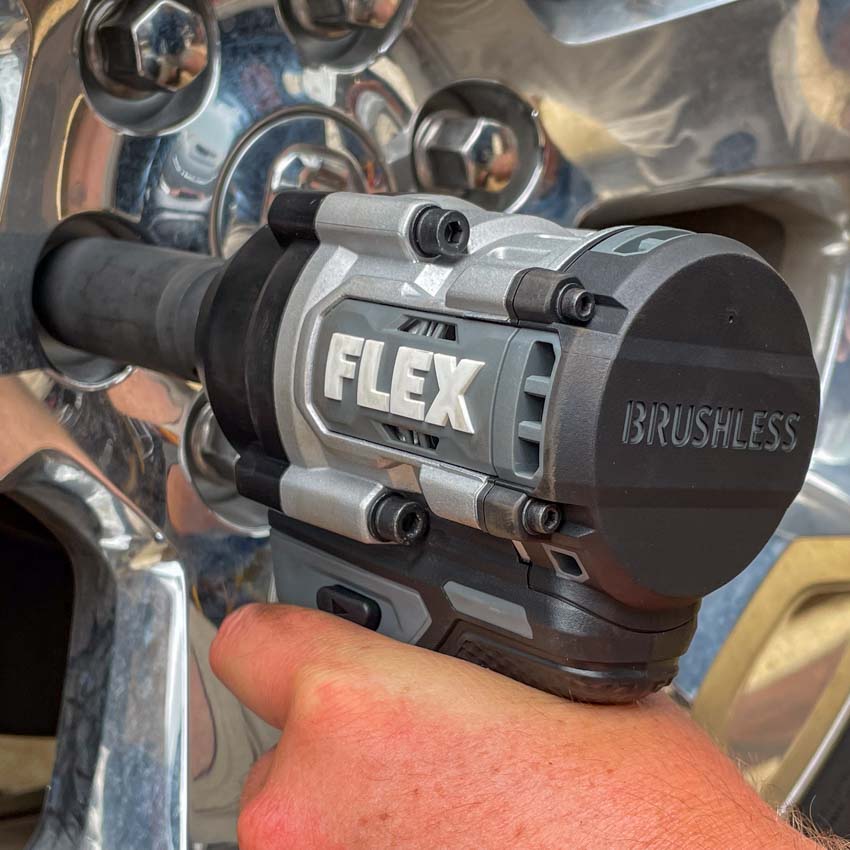
Score: 87 points
- Fastening Torque: 600 ft-bs
- Nut-Busting Torque: 750 ft-lbs
- Top Speeds: 450/1600/2700 RPM
- Max Impact Rate: 3100 IPM
- Bare Weight: 4.31 lbs
- Tested Weight: 6.58 lbs
- Length: 6.3 in
- Price: $199 bare, $329 kit
Pros
- Excellent value
- Excellent performance
- Assist mode
- Compact length
- Integrated vibration control
- Robust build quality
- Lifetime warranty
Cons
- Heavy
If you’re looking for legit Pro performance and at a better value than the Big Three, Flex is your impact wrench. Both on paper and on our torque tester, it proved to have top-tier power and maintained upper-level results on our bolt break and lag screw tests.
It’s also more compact than most, though not quite as compact as Milwaukee. Despite its shorter length, it is one of the heavier models. Using a 6.0Ah Stacked Lithium battery, it had the second-highest working weight in our test group.
From a feature perspective, there’s vibration isolation that includes both the handle and the battery. It didn’t seem like the vibration was that much lower than the others we tested. However, it may have been more effective than we realized. This is a hard-hitting impact wrench, so it’s likely we would have felt noticeably more vibration without it.
In the end, it all comes down to value for Flex. With pricing under $300 with a standard battery or $30 more with a Stacked Lithium pack, it has a much more approachable price tag than DeWalt, Makita, and Milwaukee. Just keep in mind that Flex only comes with one battery, and the others come with two. Unlike those brands, Flex offers a lifetime warranty, though.
Head-to-Head Testing Results
| Test | w/ 6.0Ah Stacked Lithium Battery |
|---|---|
| Breakaway | 3.34 sec (3rd place) |
| Inertia Torque | 414.2 ft-lbs (3rd place) |
| Lag Bolt Test | 1.13 in. (5th place) |
Need even more torque? Flex also has a high-torque model that’s also an excellent value!
Ridgid 18V Brushless Impact Wrench R86012
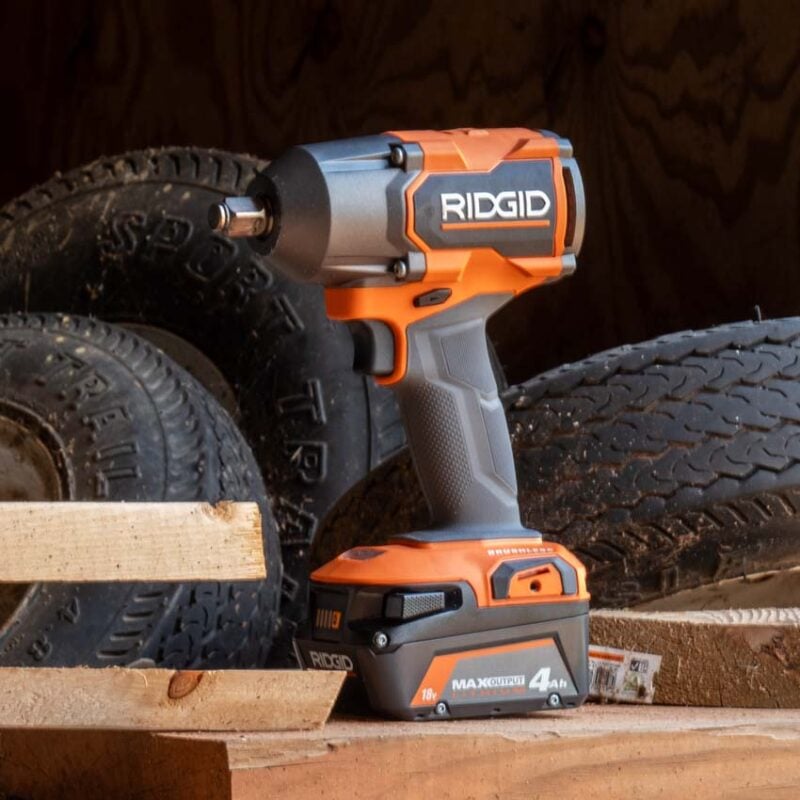
Score: 84 points
- Fastening Torque: 450 ft-bs
- Nut-Busting Torque: 600 ft-lbs
- Top Speeds: 1300/1900/2800 RPM (2000 Auto)
- Max Impact Rate: 3800 IPM
- Bare Weight: 3.69 lbs
- Tested Weight: 5.96 lbs
- Length: 6.8 in
- Price: $175 bare, $269 kit
Pros
- Assist mode
- Lifetime service agreement
Cons
- No significant drawbacks
Ridgid’s 18V mid-torque impact wrench isn’t going to “wow” you with a lot of trappings. Compared to premium models, even its performance might not garner much attention. Ignoring it would be a mistake, though. Underneath its modest exterior, it’s really an excellent impact wrench.
Its torque puts it solidly in the mid-torque class, and its class-leading impact rate helps it achieve higher fastening and loosening speeds than you might expect. It even notched an impressive 2nd-place finish in our lag screw test.
Aside from an assist mode, the feature set is basic. However, it’s not lacking anything we consider critical to a good user experience.
By skipping some of the bells and whistles other brands include, you get a lower price tag. Sitting between Ryobi and Flex in price, and with a lifetime service agreement, Ridgid offers a strong value rating for those who just want to get the job done.
Head-to-Head Testing Results
| Test | w/ 8.0Ah Max Output EXP |
|---|---|
| Breakaway | 4.21 sec (6th place) |
| Inertia Torque | 283.4 ft-lbs (6th place) |
| Lag Bolt Test | 0.31 in. (2nd place) |
Bosch 18V Impact Wrench GDS18V-330C
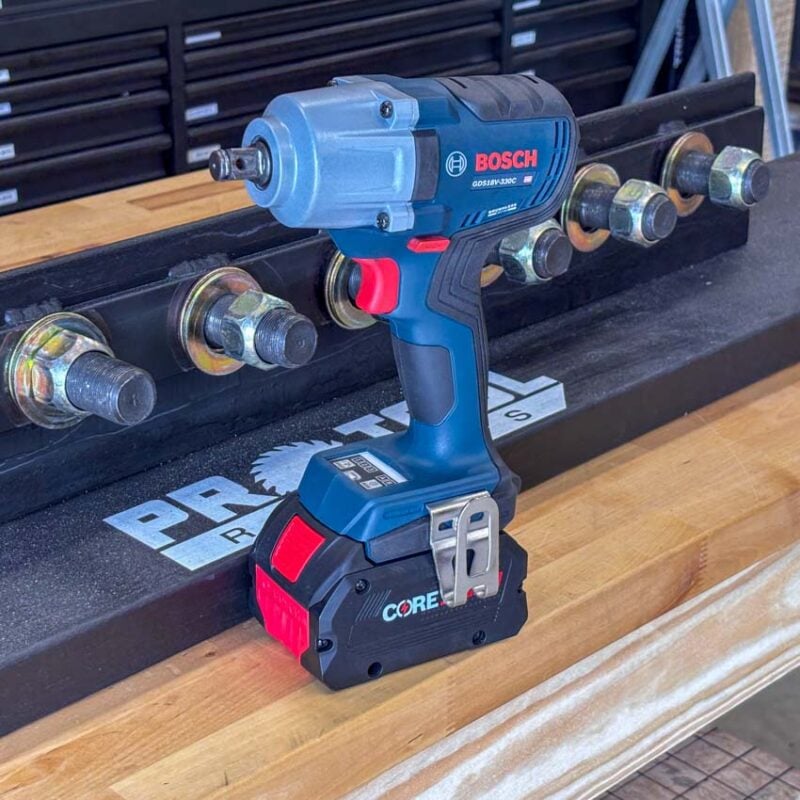
Score: 74 points
- Fastening Torque: 330 ft-bs
- Nut-Busting Torque: 590 ft-lbs
- Top Speeds: 1000/1500/2300 RPM
- Max Impact Rate: 3300 IPM
- Bare Weight: 3.46 lbs
- Tested Weight: 5.64 lbs
- Length: 6.6 in
- Price: $229 bare, $379 kit
Pros
- Assist mode
- Advanced custom controls
Cons
- Lower torque than most
- Smart transmitter sold separately
Bosch’s GDS18V-330C doesn’t claim to have the same torque levels as the others in our test and that showed in our performance results. The big takeaway here is to manage your expectations. It’s capable of handling wheel rotations on passenger vehicles with no problem along with a variety of utility and concrete applications.
Which leads us to a unique feature—Bosch’s smart controls. By adding the Bluehound Connectivity Module, you can connect to the Bosch Toolbox app and customize your controls along with access to a host of other features. It’s super-helpful for dialing in specific settings to go with common fastener and material types, such as setting concrete anchors. While the module isn’t included, it’s less than $20, so it won’t hit your budget too hard to add it.
Head-to-Head Testing Results
| Test | w/ 8.0Ah Core 18V Battery |
|---|---|
| Breakaway | 11.41 sec (10th place) |
| Inertia Torque | 228.1 ft-lbs (10th place) |
| Lag Bolt Test | 3.13 in. (tie, 10th place) |
Hilti 22V Nuron Impact Wrench SIW 6-22
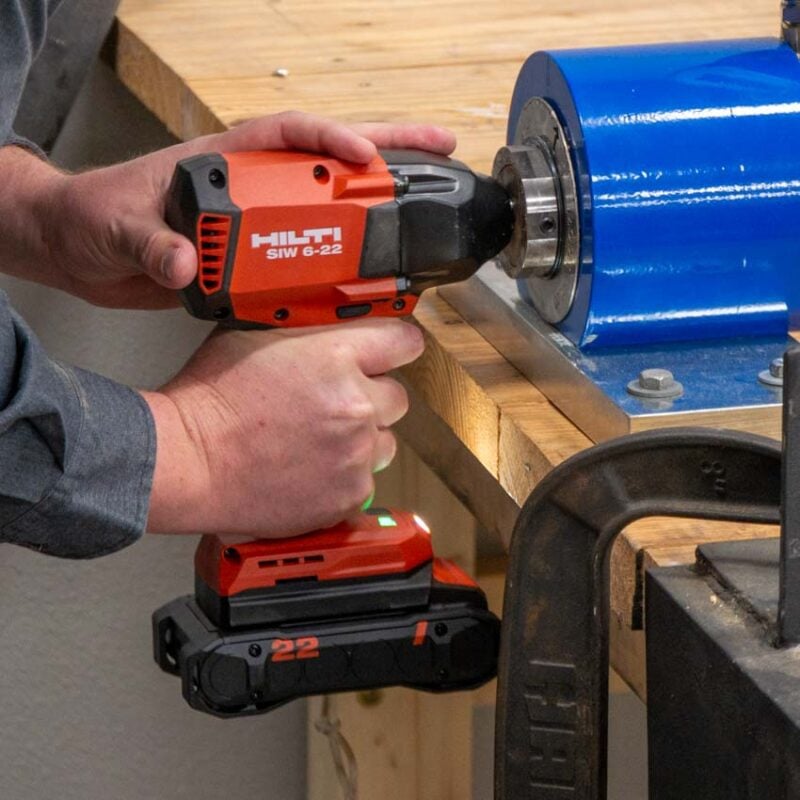
Score: 70 points
- Fastening Torque: 332 ft-bs
- Nut-Busting Torque: 479 ft-lbs
- Top Speeds: 1550/1750 RPM
- Max Impact Rate: 3500 IPM
- Bare Weight: 4.0 lbs
- Tested Weight: 6.88 lbs
- Length: 7.1 in
- Price: $379 bare
Pros
- Adaptive Torque Module available
- Rugged build quality
- 20-year warranty
Cons
- Lower torque than most
- Only two speeds
- Expensive
- Heavy
- Long head
Hilti isn’t the first name most people think of when they’re wrenching on an engine. But in concrete and commercial construction, they’re a known leader. So, as we consider Hilti’s mid-torque impact wrench, that’s the lens we need to view it through.
Somewhat mild in torque and with only two mode settings on the tool, its real power comes from adding Hilti’s Adaptive Torque Module. You start by scanning the code from your Hilti fasteners, and then the Module tells the tool how much pre-load fastening to apply. It gets you near your target torque but doesn’t exceed it, leaving a minimal amount of torque wrenching to do compared to standard methods.
Built for commercial and industrial applications, it’s a heavier, longer tool than most, and it’s expensive. However, if you’re working on the kinds of applications this model excels at, you’ll have a hard time finding a better tool for the job.
Head-to-Head Testing Results
| Test | w/ 7.9Ah Battery |
|---|---|
| Breakaway | 6.12 sec (7th place) |
| Inertia Torque | 275.7 ft-lbs (7th place) |
| Lag Bolt Test | 3.13 in. (tie, 10th place) |
Craftsman V20 Brushless RP Impact Wrench CMCF921
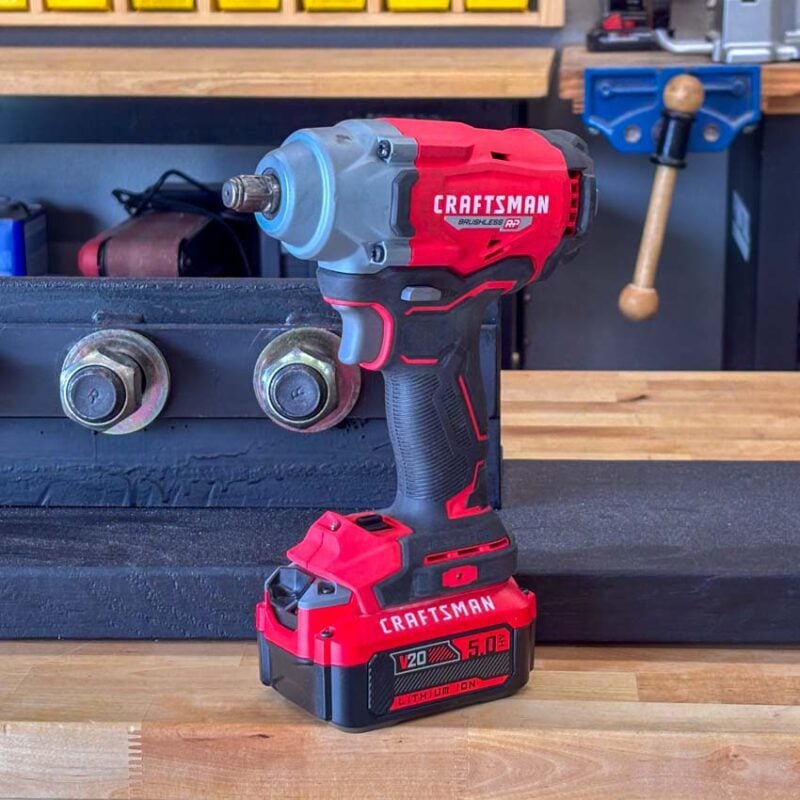
Score: 56 points
- Fastening Torque: 275 ft-bs
- Nut-Busting Torque: Not listed
- Top Speeds: 900/1900 RPM
- Max Impact Rate: 3000 IPM
- Bare Weight: 3.54 lbs
- Tested Weight: 4.95 lbs
- Length: 7.0 in
- Price: $149 bare
Pros
- Lightweight
- Lowest price in the group
Cons
- Lower torque than most
- Lower speed than most
- No kit option
- Only two speeds
Looking at Craftsman’s specifications compared to the rest of our test group, we didn’t have high expectations for its performance, and it struggled compared to the others. But does that mean it’s a bad tool?
Not at all. You simply need to understand its limitations. Producing more than 200 ft-lbs of fastening torque on our torque tester, it can handle nearly anything you run across on a well-maintained passenger vehicle along with some of the larger structural screws. It’s just not going to handle neglected fasteners and the largest structural screws well.
The fact that Craftsman is the lightest of the models we tested is appealing. Its working weight was nearly a pound lighter than the majority of the others, and it was nearly two pounds lighter than the heaviest.
That said, despite technically edging into mid-torque ratings, it was clearly a performance outsider and was lacking in features compared to the rest of the group. On the other hand, it has an attractive price tag if you’re on Craftsman’s V20 battery system and want more power than the compact CMCF911 without going all the way to the size and weight of Craftsman’s high-torque model.
Head-to-Head Testing Results
| Test | w/ 4.0Ah Battery |
|---|---|
| Breakaway | DNF (Broke 5 of 8) |
| Inertia Torque | 233.6 ft-lbs (10th place) |
| Lag Bolt Test | 3.00 in. (9th place) |
More Cordless Impact Wrench Reviews
Whether you’re fighting with stubborn lugs on a tractor or looking for an excellent value for your DIY projects, the models we tested in our head-to-head don’t cover every need. Check out these reviews for other options that might fit the bill.
High-Torque Impact Wrench Reviews
Milwaukee M18 Fuel 1-Inch D-Handle Impact Wrench 2868/2869
Ingersoll Rand 1-inch Cordless Impact Wrench W9000 Series
Bosch 18V Profactor 3/4-inch High-Torque Impact Wrench GDS18V-770
Metabo HPT 36V 3/4-in High-Torque Impact Wrench WR36DFQ4
Mid-Torque Impact Wrench Reviews
Skil PWRCore 20 Mid-Torque Impact Wrench IW5761B-10
Kobalt 24V 1/2-inch Mid-Torque Impact Wrench KIW 4024A-03
Compact Impact Wrench Reviews
Greenworks 24V 1/2-inch Compact Impact Wrench IWD401
Milwaukee M12 Fuel Gen 2 Stubby Impact Wrench 2562/2563
Flex 24V 1/2-inch Compact Impact Wrench FX1431
Cordless Impact Wrench Comparison
Battery Selection
In this test, we wanted to see how these impact wrenches performed with the best batteries available without going overboard on the size. It was all about seeing their maximum potential, but that also meant we were testing with batteries other than the ones that normally come in the kits. Here are the batteries we used:
| Model | Battery Used |
|---|---|
| Bosch GDS18V-330C | Core18V 8.0Ah GBA18V80 |
| Craftsman CMCF921 | 5.0Ah CMCB05 |
| DeWalt DCF891 | PowerPack 8.0Ah DCB2108 |
| Flex FX1451 | Stacked Lithium 6.0Ah FX0331 |
| Hilti SIW 6-22 | 7.9Ah 22-170 |
| Makita GWT07 | High Power 4.0Ah BL4040F |
| Metabo HPT WR36DE | 2.5AH BSL36A18X |
| Milwaukee 2962 | Forge 8.0Ah 48-11-1881 |
| Ridgid R86012 | Max Output EXP 8.0Ah R840080 |
| Ryobi P262 | High Performance Edge 4.0Ah PBP1104 |
Weight
Weight is straightforward but important. The lower the weight, the less fatiguing it is to use the impact wrench, especially when you’re working at shoulder height or above. Here are the weights we measured for both the bare tools and with the batteries we tested:
| Model | Bare Weight | Weight w/ Tested Battery |
|---|---|---|
| Bosch GDS18V-330C | 3.46 lbs | 5.64 lbs |
| Craftsman CMCF921 | 3.54 lbs | 4.95 lbs |
| DeWalt DCF891 | 3.83 lbs | 5.95 lbs |
| Flex FX1451 | 4.29 lbs | 6.58 lbs |
| Hilti SIW 6-22 | 3.98 lbs | 6.88 lbs |
| Makita GWT07 | 4.38 lbs | 6.45 lbs |
| Metabo HPT WR36DE | 4.25 lbs | 5.90 lbs |
| Milwaukee 2962 | 3.55 lbs | 5.95 lbs |
| Ridgid R86012 | 3.69 lbs | 5.96 lbs |
| Ryobi P262 | 3.69 lbs | 5.19 lbs |
Length
Lighter weight and a smaller size tend to go hand-in-hand, but it’s not a guarantee. Regardless of the weight, a more compact impact wrench gives you the advantage of working in tighter spaces. However, these are mid-torque models, so “compact” is relative. If you need to work in super-tight spaces, there’s an entire class of truly compact impact wrenches that are the best fit.
Here’s the head length of all the models we tested.
| Model | Head Length |
|---|---|
| Bosch GDS18V-330C | 6.63 in |
| Craftsman CMCF921 | 7.00 in |
| DeWalt DCF891 | 6.88 in |
| Flex FX1451 | 6.25 in |
| Hilti SIW 6-22 | 7.13 in |
| Makita GWT07 | 6.63 in |
| Metabo HPT WR36DE | 6.63 in |
| Milwaukee 2962 | 5.88 in |
| Ridgid R86012 | 6.75 in |
| Ryobi P262 | 7.19 in |
Speed and Torque
To get a general idea of an impact wrench’s performance, the speed tells you how fast you can drive while the torque is an indicator of how strong it is. However, don’t neglect the impact rate (IPM). When you’re driving large fasteners, having a higher impact rate delivers more impacts per minute and that’s going to make for faster driving than a higher RPM alone.
| Model | Max Speeds | Max Impact Rate | Rated Torque |
|---|---|---|---|
| Bosch GDS18V-330C | 1000/1500/2300 RPM | 3300 IPM | 330 ft-lbs fastening 590 ft-lbs breakaway |
| Craftsman CMCF921 | 900/1900 RPM | 3000 IPM | 275 ft-lbs fastening |
| DeWalt DCF891 | 600/1200/2000 RPM | 3250 IPM | 600 ft-lbs fastening 800 ft-lbs breakaway |
| Flex FX1451 | 450/1600/2700 RPM | 3100 IPM | 600 ft-lbs fastening 750 ft-lbs breakaway |
| Hilti SIW 6-22 | 1550/1750 RPM | 3500 IPM | 332 ft-lbs fastening 479 ft-lbs breakaway |
| Makita GWT07 | 600/1200/1900/2300 RPM | 2900 IPM | 560 ft-lbs fastening 810 ft-lbs breakaway |
| Metabo HPT WR36DE | 1500/1800/2100/2400 RPM | 3400 IPM | 568 ft-lbs fastening 774 ft-lbs breakaway |
| Milwaukee 2962 | 1250/1950/2575 RPM | 3100 IPM | 550 ft-lbs fastening 650 ft-lbs breakaway |
| Ridgid R86012 | 1300/1900/2800 RPM | 3800 IPM | 500 ft-lbs fastening 650 ft-lbs breakaway |
| Ryobi P262 | 1200/2000/2800 RPM | 3200 IPM | 450 ft-lbs fastening 600 ft-lbs breakaway |
How We Tested Impact Wrenches
We ran three tests on each of these impact wrenches to give you a real-world comparison of their performance. While manufacturers’ specifications can be helpful, we find they don’t always tell the whole story. That’s where our custom test rigs come into play.
Our processes involve eliminating as many variables as possible to ensure we have clean tests and data to evaluate. We toss outlier results and take the time to ensure we have consistent data to draw our conclusions from.
Inertia Torque Test
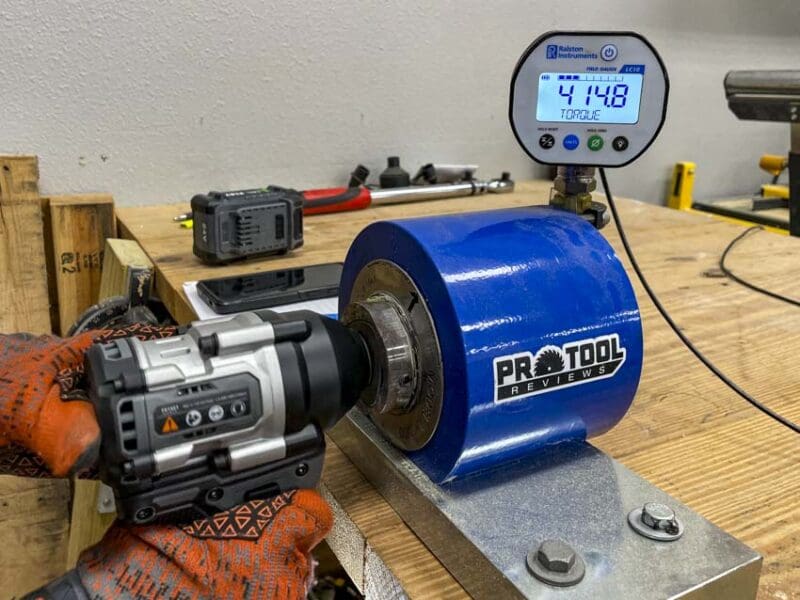
The first test we run measures torque using an L1000 torque tester from Inertia Torque. This is very different from our other tests because it only tests torque without speed or impact rate coming into play.
From Inertia Torque’s website:
“The L-1000 duplicates tightening a bolted joint, but it does so by directly measuring the torque in a more accurate and repeatable way. There are only 2 points of contact internally as it rotates, as opposed to be many points of contact in a bolted joint. All the areas where the threads mate and the face of the washer/nut/bolt meet the surface the hole the bolted joint is in. Those areas create a lot of variability in readings. This tester removes the variability and give you a true torque reading.”
Our method is to run three 5-second intervals with a 3-second break between and take the highest torque reading. This helps us understand how much actual torque the impact wrench is producing, and it is different from the method manufacturers use to rate their impact wrenches.
| Model | Measured Torque |
|---|---|
| Bosch GDS18V-330C | 228.1 ft-lbs |
| Craftsman CMCF921 | 233.6 ft-lbs |
| DeWalt DCF891 | 392.6 ft-lbs |
| Flex FX1451 | 414.2 ft-lbs |
| Hilti SIW 6-22 | 275.7 ft-lbs |
| Makita GWT07 | 502.3 ft-lbs |
| Metabo HPT WR36DE | 441.2 ft-lbs |
| Milwaukee 2962 | 412.8 ft-lbs |
| Ridgid R86012 | 283.4 ft-lbs |
| Ryobi P262 | 236.6 ft-lbs |
Lag Bolt Test
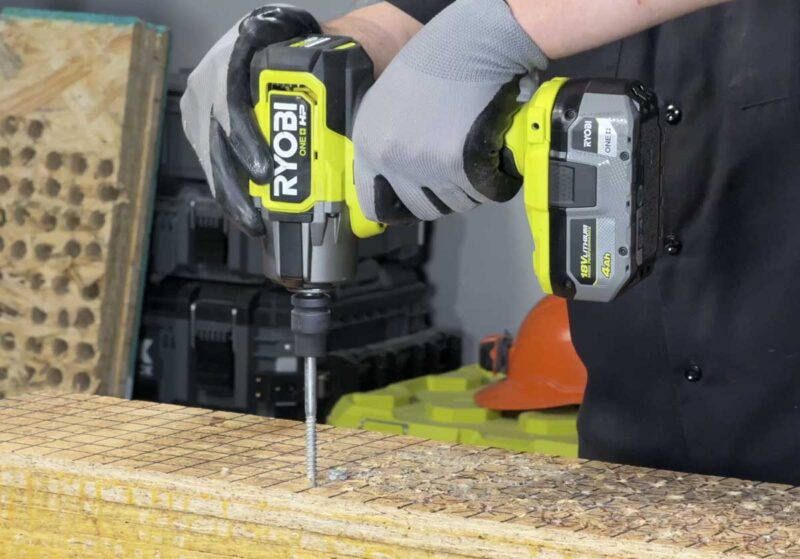
In our second test, we see how far each tool can drive a 1/2″ x 10-inch lag screw into stacked and glued OSB. We prefer OSB for this test because without knots and density variations, it’s more consistent than lumber. We run each tool for a maximum of 30 seconds and measure how much of the bolt is left standing proud, if any.
This test is harder than it would be in real construction applications. Rather than pre-drilling the entire hole, we only give it a 2-inch head start to ensure the lag goes in straight.
This test is dependent on torque, speed, and impact rate all working together. The more threads are engaged in the wood, the more torque is required to keep the screw moving. The higher the impact rate, the faster the impact wrench can continue its progress. The best results come from models that have both high torque and fast impact rates.
| Model | Remaining Length |
|---|---|
| Bosch GDS18V-330C | 3.125 in |
| Craftsman CMCF921 | 3.00 in |
| DeWalt DCF891 | 0.00 in (27.7 sec to sink) |
| Flex FX1451 | 1.125 in |
| Hilti SIW 6-22 | 3.125 in |
| Makita GWT07 | 2 in |
| Metabo HPT WR36DE | 1.4375 in |
| Milwaukee 2962 | 0.5625 in |
| Ridgid R86012 | 0.3125 in |
| Ryobi P262 | 0.375 in |
Bolt Breaking Test
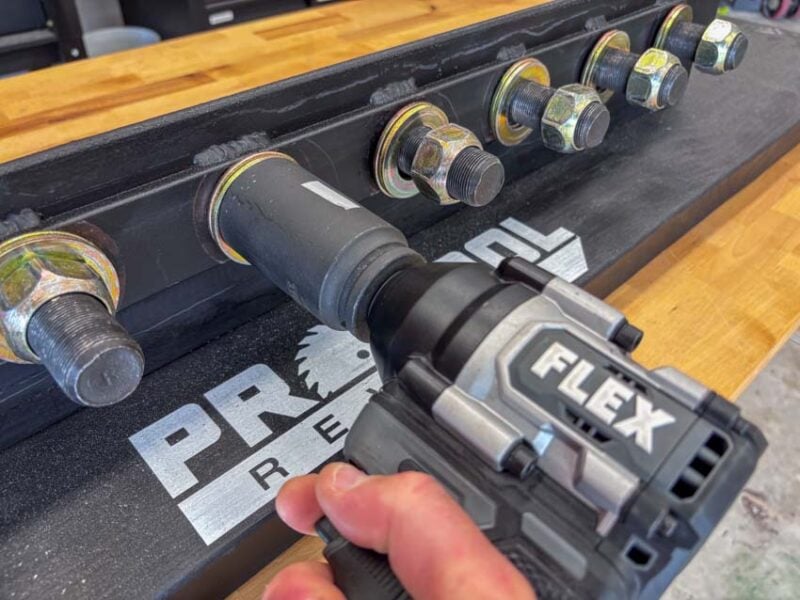
The final performance test is a straight-forward bolt-breaking application. Using a digital torque wrench, we set eight 1 1/4-inch lug nuts against their corresponding 1 1/8-inch semi truck studs to 500 ft-lbs of torque on our rig. We then use each impact wrench to break all eight nuts in sequence, and report the average amount of time it takes.
Why semi lugs? Any of the impact wrenches we tested can handle wheel rotations on a standard passenger vehicle. They are typically only tightened to 80 – 125 ft-lbs. In fact, most of these models can actually sheer the studs off in their highest performance modes. This test shows whether the impact wrench is capable of loosening the largest lug nuts on the road, and if any of them can excel in the task.
| Model | Average Break Time |
|---|---|
| Bosch GDS18V-330C | 11.41 sec |
| Craftsman CMCF921 | DNF (broke 5 out of 8) |
| DeWalt DCF891 | 2.97 sec |
| Flex FX1451 | 3.34 sec |
| Hilti SIW 6-22 | 6.12 sec |
| Makita GWT07 | 4.08 sec |
| Metabo HPT WR36DE | 6.62 sec |
| Milwaukee 2962 | 3.26 sec |
| Ridgid R86012 | 4.21 sec |
| Ryobi P262 | 4.16 sec |
What to Look For When Shopping for a Cordless Impact Wrench
Power and Speed
Whether you’re fastening or loosening, power is the name of the game for cordless impact wrenches. The more power you have, the better chance you have of getting the fastener moving quickly and not straining the motor.
Speed is secondary but still important. If you’re in construction or landscaping where you’re running long timber screws and the like, you want to run those as fast as you can while keeping them under control.
Size and Weight
Once you know how much power you need, finding it in the smallest, lightest package you can without giving up on quality is high on the list. Most impact wrenches are much heavier than impact drivers, and the vibration and noise of the tools can fatigue you quickly. Needless to say, I pay a lot of attention to the power-to-weight ratio of these tools.
In general, there are 3 primary categories to look at: compact (including stubby), mid-torque, and high-torque. You move up in power as you move up in size. Just keep in mind that today’s brushless models perform at a much higher level than before. It’s common to use a class size smaller to get the same performance as larger models from a generation or two ago.
Electronic Assistance and Smart Controls
Assist modes and smart controls are highly valued features for impact wrenches. Many fasteners have a torque rating and it’s easy to over-torque them if you’re not careful. Having an automatic stop helps you run a nut or bolt quickly and still leave it short to finish off with a torque wrench.
In reverse, auto modes can back off a fastener and stop or slow down significantly so you don’t run it completely off. When you’re working at height or just hate chasing rogue nuts and bolts, it’s incredibly helpful.
Smart controls such as Milwaukee One-Key, DeWalt Tool Connect, and Bosch Connected tools have added benefits. Inventory management and tracking are the major highlights, but there’s a lot more inside the apps that are worth considering.
Ergonomics
Impact wrenches are violent, noisy, heavy tools and ergonomics can be an afterthought in some designs. However, reducing the weight, perfecting the balance, and creating a comfortable handle all make the tool easier to use and less fatiguing on long days.
Price and Value
As always, value is an important aspect for many tool buyers. It’s not about which one is the cheapest; it’s about doing the job well while getting the most bang for your buck.
Why You Can Trust Pro Tool Reviews
Since 2008, Pro Tool Reviews has tested and evaluated cordless power tools for both construction and automotive professionals. We help our readers know which features to look for while providing comparative testing info on a tool’s performance and real user feedback. We’ve seen first-hand the changes and advances in brushless motor development as well as the dawn of smart tool connectivity.
In short, we understand how professionals use tools. You can trust Pro Tool Reviews because tools are what we do. When I recommend an impact wrench, it’s because it’s the one I would buy. I genuinely recommend tools that I believe are the best in each category based on more than 15 years of industry experience. I work around power tools each and every day. If you choose to buy something I recommend, my hope is that it works exactly the way you expect on your next project.

